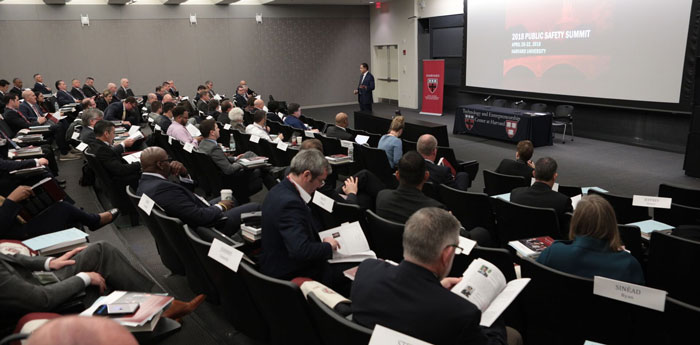Part of a Series
This Reflection is a part of the
2018 Public Safety Summit Report.
To see the complete report, click here.

Dear Colleagues:;
In a world where the legitimacy and trust in the institution of public safety is increasingly dependent on “keeping up with the times,’ how can leaders adapt policing services? How quickly? And to what end?
These aren’t necessarily new questions – society has been remixing and reformulating how we keep communities safe “since the dawn.” Yet what is new for our generation, is the level of turbulence that marks our time. The social, technological, and economic forces reshaping our world are moving at an unprecedented pace. This convergence of forces demands response from public safety organizations. People expect change. Faster. Better. Now.
This demand is the charge we took up at this year’s Public Safety Summit. Attendees travelled to Harvard with the need to transform policing top of mind. In fact, 73 percent of the attendees at the Public Safety Summit said they are under either significant or extreme pressure to innovate and improve policing services, and 89 percent ranked the importance of growing capacity in policing as “critical.”
We started our charge at the Summit by reflecting on the classic question the noted moral and political philosopher John Rawls posed: “What would a just society look like?” As we grappled with Rawls’ question in the context of modern times, we centered on the idea that innovation and transformation in policing services should revolve as quickly as possible around modernizing mission and strategy, redesigning structures, systems and processes, and fostering the next generation of human capital and culture. Yet at the same time, innovation and transformation must be governed through the imperatives of equally protecting people from evermore complex crime, equally protecting access and equity in civil rights, freedoms, and liberties, and equally engaging with communities to define value and co-create trust.
Navigating this terrain falls squarely on the shoulders of policing and public safety leaders. This will require a high degree of experimentation and innovation, while managing risk and consulting with stakeholders and the public in a rigorous way. Policing can no longer afford to be secretive. Transparent innovation will be the hallmark of the most progressive policing organizations.
This year’s Summit cases exemplified the ideas of transparent innovation. New York City, Chicago, and Los Angeles are all moving forward with innovative analytic models – and all three affirmed the need to open up the innovation process, engage with communities, and synchronize newfound capabilities with public expectations. And as we found with the business model innovations in Washington DC and New Zealand, transparent innovation holds whether the innovation is “back office” or “front office.” New Zealand positioned their public-facing innovation within a “Prevention First” framing. Washington DC built up its internal capacity by opening up roles and decision-making to civilians. The success of all these initiatives was heightened by the stellar ability of policing leaders to engage the public in rigorous and authentic ways.
As we closed this year’s Summit out, Nancy Koehn, the preeminent historian at Harvard Business School, spoke to us of the art of the possible. In turbulent times, Koehn noted, those given public trust must harness their cumulative experience, recognize that a moment has arrived that demands his or her leadership, and consciously decide to embrace the challenge.
I hope you decide to embrace the challenge of building the future of policing, and I sincerely hope the Public Safety Summit helps illuminate your journey.
Let’s get to work,
AMO
Dr. Antonio M. Oftelie
Executive Director, Leadership for a Networked World
Fellow, Technology and Entrepreneurship Center at Harvard
Harvard John A. Paulson School of Engineering and Applied Sciences
Air Jordan IV 4 Retro Snake Skin